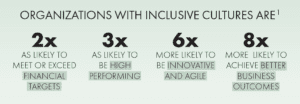The Future of Workforce
April 28, 2021 magnitude of its impact. It left no sector of the workforce unaffected. The crisis impacted the well-being and health of every single employee in some way, while also exposing systemic flaws and equity disparities at the workplace in a new light. In tumultuous times, employers are evaluating what workforce resiliency means and looking at how to strategically apply the long-term lessons brought on by the pandemic.
magnitude of its impact. It left no sector of the workforce unaffected. The crisis impacted the well-being and health of every single employee in some way, while also exposing systemic flaws and equity disparities at the workplace in a new light. In tumultuous times, employers are evaluating what workforce resiliency means and looking at how to strategically apply the long-term lessons brought on by the pandemic.
“While remote working was already on the rise pre-pandemic, adoption of telecommuting accelerated in response to the pandemic – permanently altering the way we now understand how work can be performed. Looking ahead, strategic workforce planning will demand greater focus on organizations ability to support their employees to “work from anywhere, anytime” – built on a framework that offers both temporal and location flexibility.
telecommuting accelerated in response to the pandemic – permanently altering the way we now understand how work can be performed. Looking ahead, strategic workforce planning will demand greater focus on organizations ability to support their employees to “work from anywhere, anytime” – built on a framework that offers both temporal and location flexibility.
To effectively transition to this future, organizations must adopt a coordinated strategy at all levels. This includes rapidly adopting enabling technology solutions to raise the remote flexibility of jobs, while addressing the increased security and privacy concerns that come from more people working digitally. Additionally, employers must be prepared to address intrinsic motivations, individual challenges and new opportunities, by creating the psychological safety that considers the ‘whole’ employee while building a culture of trust necessary for individuals to thrive.”
- SUMREEN AHMAD, GLOBAL CHANGE MANAGEMENT LEAD, ACCENTURE
“As we safely return to our offices, an issue that remains a priority for Honigman is our commitment to Diversity, Equity & Inclusion. Khalilah V. Spencer serves as Inclusion, Equity and Social Responsibility Partner and a partner in the Litigation Department of our Detroit office. Recently in Michigan Lawyers Weekly, she wrote that societal issues like educational inequity, economic disparities and implicit bias need to be addressed before any significant gains for diversity are visible. It will take all of us, collectively, to address these persistent racial inequities before the legal profession mirrors our diverse nation.
commitment to Diversity, Equity & Inclusion. Khalilah V. Spencer serves as Inclusion, Equity and Social Responsibility Partner and a partner in the Litigation Department of our Detroit office. Recently in Michigan Lawyers Weekly, she wrote that societal issues like educational inequity, economic disparities and implicit bias need to be addressed before any significant gains for diversity are visible. It will take all of us, collectively, to address these persistent racial inequities before the legal profession mirrors our diverse nation.
As leaders at Michigan’s largest law firm, we are strongly committed to doing our part to encourage and ensure equal voice, opportunity and legal representation for African American people and other people of color. Taking this stand, together, means valuing and insisting on diversity, inclusion and racial equity at Honigman and in our communities.”
- DAVID FOLTYN, PARTNER, CHAIRMAN AND CHIEF EXECUTIVE OFFICER, HONIGMAN LLP
“Gender equity and diversity results in increased profitability, loyal and satisfied employees, and better strategic decisions. Yet, 51 percent of the work force today is already dissatisfied with the current status of gender equality in the workplace and are willing to move to a company and a culture where they observe gender equity as an imperative. Women know that they make up over half the workforce in the U.S., but they do not see that reflected in management, executive positions, and board composition, but they note that some companies are making real progress, and everyone is watching.
employees, and better strategic decisions. Yet, 51 percent of the work force today is already dissatisfied with the current status of gender equality in the workplace and are willing to move to a company and a culture where they observe gender equity as an imperative. Women know that they make up over half the workforce in the U.S., but they do not see that reflected in management, executive positions, and board composition, but they note that some companies are making real progress, and everyone is watching.
Employers must begin to address these issues head on. Pay equity is something your company can begin to address as is providing flexible work time for women with children. Companies can implement policies that level the playing field for all women. Gender equity will not be achieved in a quarter or a year, but must start today.”
- CAROLYN CASSIN, PRESIDENT AND CHIEF EXECUTIVE OFFICER, MICHIGAN WOMEN FORWARD
“Transition, lack of control, and uncertainty are three important factors leading to higher stress, and risk to mental health. The pandemic led to expedited and fast transition of workspace, style, and relationships to a totally different format. Workers had very limited control over the transitions, and tremendous uncertainty about the form of changes and their timeline.
stress, and risk to mental health. The pandemic led to expedited and fast transition of workspace, style, and relationships to a totally different format. Workers had very limited control over the transitions, and tremendous uncertainty about the form of changes and their timeline.
The same factors will be involved in transition out of the pandemic, mostly to hybrid systems of work, but the details are still unclear to individual workers. Advanced informing about the planned stepwise transition and involving the workers in such decisions will help provide sense of control and reduce uncertainty.
We know from previous pandemics that the negative mental health impact lingers long after the pandemic is over. We need to expand available mental health services. The silver lining is that because of the pandemic, all these services are available via telemedicine, which eases access.”
- ARASH JAVANBAKHT, DIRECTOR OF STRESS, TRAUMA, AND ANXIETY RESEARCH CLINIC, WAYNE STATE UNIVERSITY SCHOOL OF MEDICINE
